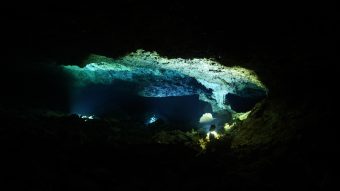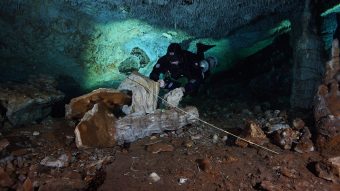July 8, 2020
Contact: Austin Fitzgerald, 573-882-6217, fitzgeraldac@missouri.edu

A team of underwater cave explorers in Mexico has discovered the oldest known system of red ochre mines in the Americas, shedding light on how humans lived as much as 12,000 years ago. The subterranean cave system, known as Sagitario, was once dry but is now completely submerged. It was mined by humans during the tail-end of the Pleistocene era for the highly valued mineral pigment.
Brandi MacDonald, an assistant research professor at the University of Missouri Research Reactor’s Archaeometry Laboratory, led the first study on the discovery in conjunction with researchers from Canada and cultural authorities in Mexico. The study dates the use of the mine system to a 2,000-year period between 10,000 and 12,000 years ago. It also shows that ochre mining played a key role in determining not only how Paleoindians used land, but how they worked as a group to adapt to ecological challenges as sea levels rose and so-called megafauna — large animals such as wooly mammoths and giant sloths — went extinct.

“Until now, no one was really sure why this region’s earliest inhabitants were exploring underground cave systems,” MacDonald said. “The incredibly well-preserved artifacts discovered in Sagitario, including fire pits, makeshift tools and remnants of human-made paths, show us that ochre mining was a large-scale industry. These caves were vital for harvesting ochre that could have been used in painting, jewelry, hide-tanning and many other applications.”
MacDonald believes the extent and intensity of the mining activities suggests that ochre was a highly valued mineral resource. The fact that the large-scale mining operations took place in the cave system during a period of rapid environmental change also indicates what MacDonald considers to be a remarkable level of social organization from a hunter-gatherer society.
In 2017, in association with the Subdirección de Arqueología Subacuáica, part of the Government of Mexico’s Instituto Nacional de Antropología e Historia, the international team of divers went further into the cave system than ever before. Less than 10 kilometers inland from popular beaches on the Yucatán peninsula, the divers navigated narrow passages and plunged nearly 230 feet underwater to take photos and video that allowed off-site researchers — such as MacDonald — to study the caves in detail.
In turn, MacDonald studied the evidence of human activity in the mine to learn more about the people who

explored the underground caves. These people were known as Paleoindians — those who inhabited the Americas at the end of the most recent Ice Age about 12,000 years ago. In addition to human skeletons and stone cairns used as navigational markers, these Paleoindians also left behind charcoal in the caves, leaving blackened and fire-reddened deposits as they used it to light their way through the subterranean passages. Through radiocarbon dating of the charcoal, MacDonald and her colleagues showed that humans were actively mining red ochre in at least three Yucatán cave systems for a nearly 2,000 year period beginning about 12,000 years ago, before the caves were flooded in a period of global sea level rise.
“Subterranean mining carries inherent risks, and doing so to such an extent during this period is remarkable,” MacDonald said. “Continuing research will focus on determining the extent of the mining activities at other submerged cave sites in the Yucatán Peninsula.”
MacDonald said that while the Mayans are known to have mined caves for pigments and other resources beginning after 4,000 years ago, this is the first known example of red ochre cave mining by Paleoindians. This discovery helps researchers understand later cave mining as a continuation of the knowledge and activities of earlier peoples.
The study, “Paleoindian ochre mines in the submerged caves of the Yucatan peninsula, Quintana Roo, Mexico,” was published in Science Advances. Other researchers involved in the study were David Stalla of the University of Missouri; Marc D. Marino of the University of Arkansas; James C. Chatters of forensics consulting firm Applied Paleoscience and radiocarbon dating service DirectAMS; Eduard G. Reinhardt of McMaster University; Fred Devos, Sam Meacham and Chris Le Maillot of Centro Investigador del Sistema Acuífero de Q Roo; Dominique Rissolo and Eric Lo of the University of California, San Diego; Barry Rock of the University of New Hampshire; and Pilar Luna Erreguerena of the Instituto Nacional de Antropología e Historia.



